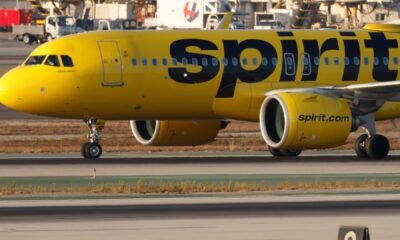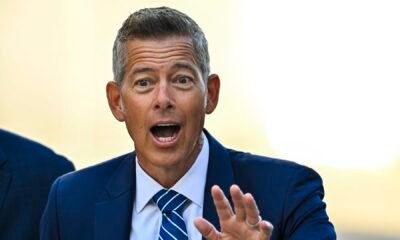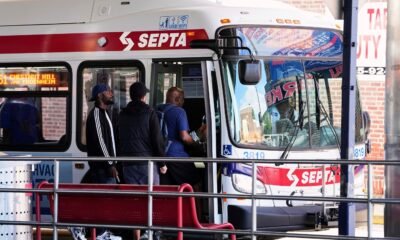Travel Guides & Articles
Confidence Shift Downgrades Q1 U.S. Airline Forecasts

First-quarter results from major U.S. carriers will be
softer than anticipated at the start of the year based on executive comments
made Tuesday at the J.P. Morgan Industrials Conference in New York. Four of
five airlines that presented today also released updated guidance for the
quarter, with revenue projections downgraded.
Some noted a softening in both corporate and consumer
demand. Some noted the wildfires in California and the weather events in the
south in January. There were two plane incidents—the fatal American Airlines
crash in January in Washington, D.C., and the Delta aircraft flipping over upon
landing in Toronto in February. Add to that general macro-economic uncertainty,
and that affects demand.
After the American incident in January, “we saw a
pretty immediate stall in both corporate travel and bookings—not that they
stopped, but the growth rates that we had been on stalled considerably,”
Delta Air Lines CEO Ed Bastian said. “And consumer confidence, certainly
in air travel, started to wane a little bit as questions of safety came.”
Prior to that incident, Delta’s corporate revenue had been
growing 10 percent year over year for the quarter. “That dropped into the
low-single digits quickly,” he added, and “that close-in booking,
that corporate confidence, that consumer sentiment continues to stay a bit
lagged.”
Then the Delta incident occurred on Feb. 17, but Bastian
said the change in consumer sentiment went beyond the accidents. “There
was something going on with economic sentiment, something going on with
consumer confidence,” he said.
The good news cited by executives, however, is that oil
prices are down about $10 a barrel from their peak during the quarter; each has
adjusted capacity and revenue management to account for the short-term softness,
so they anticipate better results in the second quarter. International demand
remains strong, and premium demand remains strong.
What’s happening now “doesn’t change … the structural
changes that have happened in the industry, what’s happening in the long term,”
United Airlines CEO Scott Kirby said. “Nothing that we’ve seen in the
short term impacts what we think is going to be happening even a year from now.”
Following are guidance changes and highlights from five
carriers that presented today.
American Airlines
American updated its guidance for total revenue in the first
quarter to down 2 percent year over year compared with prior projections of 3
percent to 5 percent gains. CEO Robert Isom acknowledged the January crash had
a significant impact on its revision, but also noted “the uncertainty in
the economy right now, and then certainly the domestic weakness in March,”
he said.
Isom did, however, note that progress is continuing in
recapturing corporate share. “Business has been holding up a little bit
better than the domestic, and from a high-end leisure perspective as
well,” he said. “That’s beneficial to American right now.”
Asked about whether some corporate share was permanently
lost, he replied, “no. And the reason is I’ve been out there as much as
anybody else on our team, talking to CEOs and corporate buyers and the travel
management companies and to a person, they all say, ‘Hey, we’d much rather have
more competition than less.’ And so the door is open, right? And you have to
come in there with a compelling offering. And from that perspective, we’ve
retooled our sales and distribution teams. You’ve seen that we’ve reorganized
on that front.”
As for the government layoff impact, Isom said the carrier’s
government contracted business for is about 1.5 percent of total revenues, but
“there is associated impact to that,” he said. “The 1.5 percent
is just our straight government contracted, but there are government
contractors that have been impacted. And anyone as well in that area is feeling
the concerns of uncertainty.”
Delta Air Lines
Delta lowered its first-quarter revenue forecast to an
increase of 3 percent to 4 percent from initial guidance of up 7 percent to 9
percent, citing a shift in corporate as well as consumer confidence and softer
close-in demand than anticipated.
The company recalibrated its inventory strategies and
“we’re now in a good place. … We have a sense that March will be the
bottom in terms of what we’re seeing,” Bastian said.
President Glen Hauenstein echoed that sentiment, saying the
carrier had been saving 2 percent of seats for close-in demand.
“Essentially those seats went unsold in February and March and probably
into April,” he said. But “we’re confident that as we move into the
second quarter the worst is behind us.”
For the quarter, Delta projects it will be $500 million
short of the first-quarter revenue target it had been anticipating. About a
quarter of that figure is related to corporate growth rates coming down,
Bastian said.
“We talked to all of our corporate customers, and
everyone is ready to go,” Bastian said. “But in the face of the
amount of macro uncertainty that’s out there, I think people are cautious. They’re
pulling back a little bit on travel, not in an organized manner, but just kind
of waiting to see what’s going to transpire whether it’s trade and tariff
challenges or macroeconomic policy changes or just a little bit of the
unsettledness of the market that we all see.”
The carrier receives less than 1 percent of its revenue from
direct government business and 4 percent of revenue from the Washington area,
Bastian added. “It’s the one area of the country that we’re the least
exposed.”
JetBlue
JetBlue updated its first-quarter revenue guidance to flat year
over year compared with a prior projection of down 0.5 percent to up 3.5
percent.
On the demand environment, “I know many carriers went
before us and just wanted to reiterate that we are seeing what others are
seeing,” JetBlue CEO Joanna Geraghty said. “The peaks remain healthy.
The troughs obviously are under pressure.”
The carrier also is adjusting capacity slightly downward, to
a decrease of 4 percent to 5 percent year over year from a projection of down 2
percent to 5 percent.
“We’ve got capacity down largely associated with storms
in February, as well as self-help measures that we took pulling capacity in
March and April as we saw the trough periods,” Geraghty said.
Regarding the carrier’s quest for a partnership, “the
construct would not look like the Northeast Alliance” it had with
American, Geraghty said. “It would look more like a traditional
partnership. And is there a sense of urgency? Yes, there is, but we need to
make sure we have the right construct for JetBlue.”
As for its sales make-up, JetBlue has been vocal about
focusing on being a leisure airline, but when asked about if it still wanted
corporate business, Geraghty said, “we definitely still have our corporate
workforce out there. It’s the same size it was pre-Covid, post Covid. They
remain focused on those opportunities. We have a product that works for
everybody.”
Southwest Airlines
Southwest updated its first-quarter guidance to project
revenue per available seat mile to be up 2 percent to 4 percent compared with
prior estimates of up 5 percent to 7 percent.
Roughly one point of that thee-point reduction, Southwest president and CEO Bob Jordan said, was due
to onetime impacts,
including a reduction in government travel. The remaining two points “are
primarily due to softness in bookings and demand in large part due to the macro
environment,” he added.
When addressing the carrier’s recent performance, Jordan
said that “on the revenue front, over many years, we also fell behind in
revenue generation as our peers introduced a host of things that we did not
pursue at Southwest, like bag fees, basic economy, assigned and premium seating
monetization, dynamic pricing, redemptions and much more. The cost increases,
combined with not pursuing these key revenue opportunities, resulted in margin
contraction at Southwest compared with our better performing peers.”
Jordan added that since laying out its new initiatives at
its Investor Day in September 2024, “we have made excellent progress on
all the things that have been previously announced,” he said.
On today’s announced bag fees, “the first bag will be
free for our tier customers as well as Chase Rapid Rewards Visa holders. Our
higher tier and Business Select customers will continue to have two free bags.
And in addition to bag fee revenue, we believe that this move will drive new
enrollments in our co-brand credit card program. Additionally, we carry nearly
two times the bags as compared to the competition, which is costly on many
fronts. So, I expect operational benefits there as well.”
Southwest expects the initiatives announced today to add an
incremental $800 million in EBIT contribution in 2025 and an incremental $1.7
billion in EBIT in 2026, Jordan said. “This brings the total estimated
EBIT contribution for our portfolio of initiatives to $1.8 billion in 2025 and
$4.3 billion in 2026. Importantly, the initiatives discussed today are targeted
at making fundamental improvements to the performance of our core and base
business.”
United Airlines
United previously did not provide revenue guidance, and it
did not issue an update to its overall outlook this week.
“We have also seen weakness in the demand market,”
Kirby said. “It started with government. Government is 2 percent of our
business. Government adjacent, all the other consultants and contracts that go
along with that are probably another 2 percent to 3 percent. That’s running
down about 50 percent right now, so a pretty material impact in the short term.
… The good news is that international, long haul, Hawaii, premium, all remain
really strong.”
Kirby added that the carrier has started the process of
where capacity is coming out. “A lot of it is transborder, a big drop in
Canadian traffic to go into the U.S.,” he said. “Some of it’s going
to come out in government markets where we’ve seen less demand. And we’re also
going to cancel red-eye flights. Utilization flying is generally unprofitable
at airlines even in good times, and it’s really unprofitable in bad times. So,
we’re taking those proactive steps.”
By April, “we’re not doing that anymore,” he said.
“We’ve adjusted [the] yield management system.”
Kirby also noted that “the airport authorities have
killed the low-cost carrier business model in the big cities. There’s going to
be a lot less low-cost carrier capacity. I think there’s a niche that works for
the low-cost carriers of point-to-point, but the niche doesn’t involve a big
city, a big, high-cost airport at one end. … The reality is what happened to
the LCC, ULCC business model is they outgrew their total addressable market
size in the United States. And that got exacerbated when we all eliminated
change fees. That was a huge, huge market share advantage.”
When asked about Southwest
Airline’s changes announced Tuesday about charging for checked bags, “I
think it will be a really big deal for Southwest,” Kirby said. “It will
be good for everyone else. [It’ll] make them more competitive. But it mostly
impacted the low-end customers. … But I think it will raise the tide for
Southwest across the board. The relative margins will be worse in competitive
markets, because it will cause some customers at the margins to switch to
competing airlines.”
Travel Guides & Articles
IRCTC to lead India’s participation at International Tourism Expo Vietnam 2025 with ASEAN-India Pavilion

NEW DELHI: The Indian Railway Catering and Tourism Corporation (IRCTC), a Government of India enterprise, has been entrusted with the responsibility of organising India’s participation in the prestigious International Tourism Expo (ITE) Vietnam 2025.
This comes after Prime Minister Narendra Modi announced 2025 as the ASEAN-India Year of Tourism, marking a renewed commitment by India to strengthen its cultural, economic, and tourism ties with ASEAN countries.
This expo is being organised from 4 to 6 September this year at the Saigon Exhibition and Convention Centre (SECC) in Ho Chi Minh City, Vietnam.
The Prime Minister’s bold proclamation essentially outlines the pivotal role of tourism in improving people-to-people connectivity, fostering mutual prosperity, and strengthening the bonds of friendship between India and the ASEAN countries.
According to an official source, IRCTC is setting up an exclusive ASEAN-India Pavilion that will showcase a diverse range of tourism offerings from India. These include the country’s rich cultural heritage, spiritual and wellness packages, natural beauty, adventure activities, and premium travel products such as the world-class IRCTC luxury trains: the Maharajas’ Express, the Golden Chariot, and the Buddhist Circuit luxury AC train.
Vipra Pandey, Consulate General of India, inaugurated the ASEAN-India Pavilion in Ho Chi Minh City.
Travel Guides & Articles
Pak-led UN panel refuses to relax Taliban minister's travel ban for India visit: Report | India hasn't recognised Afghan Taliban govt yet | Inshorts – Inshorts
Travel Guides & Articles
Breaking News IRCTC Leads the Charge in the Booming ASEAN-India Tourism Sector at International Tourism Expo Vietnam 2025 – Travel And Tour World
-

 Business1 week ago
Business1 week agoThe Guardian view on Trump and the Fed: independence is no substitute for accountability | Editorial
-
Tools & Platforms4 weeks ago
Building Trust in Military AI Starts with Opening the Black Box – War on the Rocks
-

 Ethics & Policy1 month ago
Ethics & Policy1 month agoSDAIA Supports Saudi Arabia’s Leadership in Shaping Global AI Ethics, Policy, and Research – وكالة الأنباء السعودية
-

 Events & Conferences4 months ago
Events & Conferences4 months agoJourney to 1000 models: Scaling Instagram’s recommendation system
-

 Jobs & Careers2 months ago
Jobs & Careers2 months agoMumbai-based Perplexity Alternative Has 60k+ Users Without Funding
-

 Education2 months ago
Education2 months agoVEX Robotics launches AI-powered classroom robotics system
-

 Podcasts & Talks2 months ago
Podcasts & Talks2 months agoHappy 4th of July! 🎆 Made with Veo 3 in Gemini
-

 Education2 months ago
Education2 months agoMacron says UK and France have duty to tackle illegal migration ‘with humanity, solidarity and firmness’ – UK politics live | Politics
-

 Funding & Business2 months ago
Funding & Business2 months agoKayak and Expedia race to build AI travel agents that turn social posts into itineraries
-

 Podcasts & Talks2 months ago
Podcasts & Talks2 months agoOpenAI 🤝 @teamganassi























